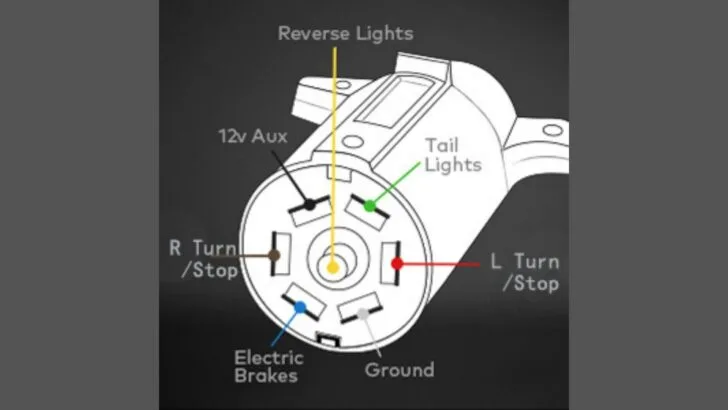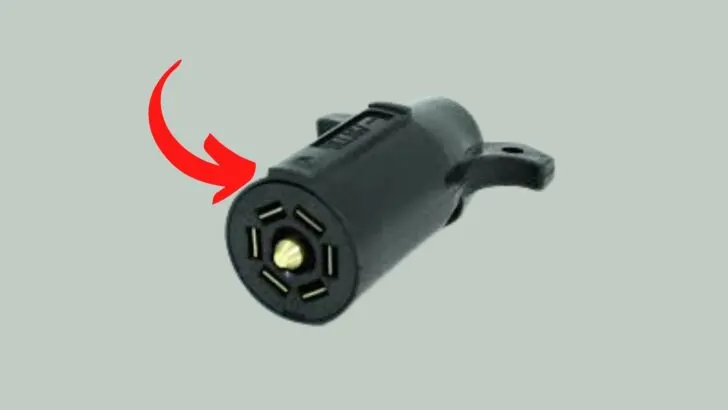Today we’re looking at the 7-pin trailer plug. We’ll talk about what it is, how it works, and what it does. We’ll also cover whether all 7-pin trailer plugs are the same and whether or not they’re intended to control your trailer’s brakes.
As a bonus, we’ll even toss in a video on how to wire a 7-pin trailer plug.
That’s a lot to cover, so let’s get rollin’!
What Is a 7-Pin Trailer Plug?
When you’re towing any type of trailer, it’s imperative that your trailer is capable of signaling to drivers behind you what your operating intentions are. So, when you’re about to make a turn or when you’re backing up or braking, your trailer needs to indicate these intentions and actions for other drivers to be able to anticipate. In order to do that, there must be power to the trailer.
A 7-pin plug (sometimes referred to as the “7-way trailer connector”) is the connector and heavy-duty wire that brings the necessary power and related functions to the trailer you’re towing.
The connector is 2″ in diameter and is often found on heavy-duty trailers such as RVs, cargo trailers, aluminum trailers, dump & landscape trailers, and car haulers.
What Does a 7-Pin Trailer Plug Do?
The 7 pins on the plug deliver power/signaling to 7 different actions/connections on the trailer connector. And yes, these do include the trailer lights.
Let’s take a look at the wires of each of the 7 pins of one RV 7-pin trailer plug, in particular, to see what function is powered by each wire leading to those pins.
IN GENERAL, this is the wiring scheme you’re most likely to find on 7-pin RV trailer plugs:
- Red = left turn signal/stop
- Brown = right turn signal/stop
- Green = tail lights
- Blue = electric brakes
- Yellow = backup/reverse or auxiliary lights
- Black = 12V battery connector
- White = ground wire

Note that not all 7-pin trailer plugs, and in fact not all RV plugs, are wired to the same color pattern. For this reason, it’s important to wire according to function as opposed to color. The raised piece of the plug, shown on the top of the plug in this photo, can help to orient you to the pins.
It’s important to note that not all 7-pin plugs will be wired according to this same color pattern.
Are All 7-Pin Trailer Plugs the Same?
The answer to this important question is no.
First of all, there are different types of 7-pin trailer plugs in general – not all are wired for RVs.
It’s also important to know that not all manufacturers color-coordinate their plugs in the same way. This is frustrating, but it’s an important fact to keep in mind.
It’s always best to coordinate your plug blades/wires with the appropriate functions rather than by wire color. Relying on wire colors may not be appropriate as different plugs use different wire colors for different functions.
So, the most important thing to do when wiring in a new 7-pin plug is to make absolutely sure you’re coordinating the proper pin/wire with the proper function.
There is a raised portion on the circular plug. That raised piece should be at the top of the plug. This may help in orienting the wiring based on the location of the pins.

You can use the top of the plug to orient you to the locations of the pins, each of which corresponds with a different function.
Does a 7-pin Trailer Plug Control Brakes?
No. A 7-pin trailer plug does not, itself, control or engage the brakes themselves. It simply provides a connection between the towing vehicle and the trailer. A brake controller is necessary to actually modulate/control the brakes for this purpose.
The plug does, however, control multiple light functions, including the brake LIGHTS.
In fact, on some 7-pin plugs, more than one wire provides a signal for braking.
For example, some plugs have a single wiring pin that controls the left turn signal AND brake lights and a single wiring pin that controls the right turn signal AND brake lights. These plugs also have a separate wiring pin to control only the brake lights.
So, while the 7-pin trailer plug provides the wiring to control the brakes, to engage/control the brakes, a brake controller in the towing vehicle is required.
Can I Change My 4-Pin Trailer Plug to a 7-Pin Trailer Plug?
You can. The easiest way to replace a 4-pin plug with a 7-pin plug is to use a wiring kit that makes the change from 4 wires to 7 as seamless as possible. Something like this would make the appropriate connections:
- This adapter converts 4 way flat vehicle end to 7 way blade trailer end, makes a tight connection between vehicle socket and trailer plug, no...
- 4-pin flat socket designed to be converted to the 7-pin blade round type socket. Works on most vehicle wiring components like turn signals, brakes,...
Can I Replace My 7-Pin Plug?
You absolutely can! Plugs may need to be replaced due to damage or other aging conditions. This is something you can have professionally completed, or you can do it as a DIY project.
If you choose to take this on as a DIY project, there are several ways you can go. The most complete would be to replace the entire wiring harness, including the cable itself and the plug:
- ✔ BougeRV trailer plug is made from flameproof ABS junction box, good conductivity copper and solid cord. 4 open & 4 close...
- ✔ There are several recognized wiring color code conventions on the 7-way trailer connector. Connected by function, not only by color. PLEASE FOLLOW...
Or, if the cable itself is still in good shape, but you just need to replace the plug end, you can get a replacement like this:
- EASY GRIP. Plugging in your trailer wiring and trailer lights is comfortable and easy with the ergonomic design of this heavy-duty trailer plug. It...
- WEATHER-RESISTANT. This trailer wiring plug comes with concealed wire terminals. This helps protect the splice-in connection points for the wires,...
Or, if it’s the 7-pin port on your towing vehicle that needs to be replaced, you’ll need this:
- PROTECTED. This 7-way RV blade socket is equipped with a spring-loaded dust cover that keeps the connection points dry and protected when not in use,...
- WEATHER-RESISTANT. This trailer wiring socket comes with concealed wire terminals. This helps protect the splice-in connection points for the wires,...
You may also like to reference a video such as this one from etrailer.com to give you a visual aid. This will also explain how to determine what functions correspond with the pins on the plug.
Important Towing Tips
Anytime we have a chance, we like to refer our readers to our post on trailer sway control. These are incredibly important towing tips to keep you safe on the road.
Since the topic of this post has to do with trailers, we thought we’d take the opportunity to sneak it in again.
Geek Out with Us Every Week
Join our newsletter to learn about all things RV-related. Every week we offer free tips, tricks, product reviews, and more to our online community of RVers. So, whether this is your first time on the road or you’re a seasoned expert, we’d love for you to geek out with us!






PAM
Saturday 4th of November 2023
Can you clean the pins in a 7 pin trailer plug? What with?
TheRVgeeks
Saturday 4th of November 2023
Sure thing, Pam. You can use something like CRC Contact Cleaner (you can get it at big box hardware stores or on Amazon: https://amzn.to/3Mwx94t). It will help to rinse & remove any grease and debris from the plug. Though you may also have to use something to physically remove the worst dirt/mud... just be very careful not to damage the contacts inside.
Myron T.
Friday 22nd of September 2023
I would love to have the supplier of the crimps on ends of the wires in the very first picture. What a great idea. This should extend the life of the connections for sure.
TheRVgeeks
Monday 25th of September 2023
We know! We've looked and looked, but haven't been able to locate those crimped ends! If anyone finds them, please point us (all) in the right direction!
Lou F
Saturday 24th of September 2022
Ummm..in your breakout list of the wiring to the pins, blue is not brake lights, that's the "stop" in the left and right signal wires noted above it. Blue is used by the variable brake controller to activate the brakes. So yes the 7pin does not control the brakes in and of itself without a brake controller, but it does provide the necessary wiring to do so!
Paul Thorpe
Friday 23rd of September 2022
Gentlemen,
You said:"A 7-pin trailer plug does not control or engage the brakes themselves. A brake controller is necessary for this purpose.
The plug does, however, control multiple light functions, including the brake LIGHTS."
If the plug controls the lights, it also controls the brakes. Of course neither statement is correct. the plug merely transmits the signals from the controlling devices in the the tow vehicle, the brake light switch, the turn signal switch or the trailer brake controller.
Brad
Friday 23rd of September 2022
I'm considering adding a DC-DC charger to help with charging my LiFePO4 batteries. Can I connect the charger to the 12V battery wire? If so, what charger (brand and amperage) would you recommend using? Thanks!
TheRVgeeks
Saturday 24th of September 2022
Hi Brad. Yes, that will work, but the small gauge of the wiring through the RV-to-tow/towed vehicle cable will reduce/limit the amount of current able to flow between the two vehicles. You may need to check that cable to see what gauge wire is used, so you don't install too powerful of a DC-to-DC charger. One, that would be a waste as the power isn't going to get through and (2) it could be a fire hazard risk since the small wiring could overheat from too much power flowing through it.
There are good DC-to-DC chargers available from companies like Xantrex (the Echo Charger), Sterling, Victron, or Renogy. We don't have direct experience with ANY of these units... but we have Xantrex equipment we love, our friends the Mortons use lots of Victron equipment and have excellent experiences with it, and another friend installed a Renogy DC-to-DC on their Class C and has had good luck with it. So we don't think you can go wrong.